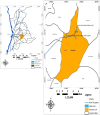Soil-transmitted helminthiasis among adolescents in Anaocha Local Government Area, Anambra State, Nigeria: Insights and recommendations for effective control
- PMID: 39774414
- PMCID: PMC11706410
- DOI: 10.1371/journal.pone.0292146
Soil-transmitted helminthiasis among adolescents in Anaocha Local Government Area, Anambra State, Nigeria: Insights and recommendations for effective control
Abstract
Over the past decade, Anambra State, Nigeria, has implemented mass administration of medicines (MAMs) to combat soil-transmitted helminthiasis (STH), a significant public health challenge in low-income regions. Nevertheless, these efforts have predominantly focused on pre-school and school-aged children, leaving a notable gap in understanding STH infection rates and the efficacy of these campaigns among secondary school adolescents, who have been excluded from this initiative. Our study aimed to address this critical knowledge gap by assessing soil-transmitted helminthiasis (STH) prevalence and contextual factors hindering effective control among adolescents in Anambra State, Nigeria. We actively engaged 443 adolescents with a mean age of 14 years in a school-based cross-sectional study in selected communities within the Anaocha Local Government Area from 8 February to 7 July 2023 following informed consent and assent procedures. Employing a stratified random sampling technique, we collected demographic data and assessed STH risk factors using a structured questionnaire hosted on the Kobo Toolbox platform. For quantitative analysis of STH infections, the Kato-Katz technique was used. Analysis was performed using SPSS version 25, incorporating descriptive statistics and multinomial logistic regression, with statistical significance set at p<0.05. Of the 443 (213 males (48.0%) and 230 females (52.0%) adolescents studied, the overall prevalence of STH observed was 35.2% (156/443). Ascaris lumbricoides was the prevalent STH species (16.9%), followed by Trichuris trichiura (1.4%) and hookworm (0.5%). Only light-intensity infection was observed. Mixed infections were observed in 16.5% of adolescents, involving A. lumbricoides and hookworm (10.8%), followed by A. lumbricoides and T. trichiura (3.2%) and all three STH (2.5%). The observed overall prevalence was not statistically significant with respect to gender (OR: 0.961; 95% CI: 0.651-1.420; p > 0.05) or age (OR: 0.686; 95% CI: 0.459-1.025; p>0.05). Class (grade level) (OR = 1.75, 95% CI: 1.25-2.45, p = 0.003), knowledge and transmission of STH infection (OR = 0.60, 95% CI: 0.42-0.86, p = 0.008), parental occupation (OR = 1.90, 95% CI: 1.35-2.67, p < 0.001), parents' literacy level (OR = 0.68, 95% CI: 0.48-0.96, p = 0.027), and the type of toilet (OR = 2.15, 95% CI: 1.54-3.00, p < 0.001) were all significantly correlated with STH infection. These findings highlight the role of adolescents in sustaining soil-transmitted helminthiasis (STH) transmission. Coupled with school-based deworming expansion, innovative improvements in water, sanitation, hygiene, and awareness can provide a cost-effective, sustainable solution for combatting STH infections in Anambra State.
Copyright: © 2025 Aribodor et al. This is an open access article distributed under the terms of the Creative Commons Attribution License, which permits unrestricted use, distribution, and reproduction in any medium, provided the original author and source are credited.
Conflict of interest statement
The authors have declared that no competing interests exist.
Figures




Similar articles
-
Epidemiology of soil-transmitted helminthiasis among school-aged children in pastoralist communities of Kenya: A cross-sectional study.PLoS One. 2024 May 23;19(5):e0304266. doi: 10.1371/journal.pone.0304266. eCollection 2024. PLoS One. 2024. PMID: 38781162 Free PMC article.
-
Factors associated with soil-transmitted helminths infection in Benin: Findings from the DeWorm3 study.PLoS Negl Trop Dis. 2021 Aug 17;15(8):e0009646. doi: 10.1371/journal.pntd.0009646. eCollection 2021 Aug. PLoS Negl Trop Dis. 2021. PMID: 34403424 Free PMC article. Clinical Trial.
-
Soil-transmitted helminth infection in school age children in Sierra Leone after a decade of preventive chemotherapy interventions.Infect Dis Poverty. 2019 Jul 2;8(1):41. doi: 10.1186/s40249-019-0553-5. Infect Dis Poverty. 2019. PMID: 31262367 Free PMC article.
-
Prevalence and distribution of soil-transmitted helminth infections in Nigerian children: a systematic review and meta-analysis.Infect Dis Poverty. 2018 Jul 9;7(1):69. doi: 10.1186/s40249-018-0451-2. Infect Dis Poverty. 2018. PMID: 29983115 Free PMC article.
-
Soil-transmitted helminths and schistosome infections in Ethiopia: a systematic review of progress in their control over the past 20 years.Parasit Vectors. 2021 Feb 5;14(1):97. doi: 10.1186/s13071-021-04600-0. Parasit Vectors. 2021. PMID: 33546757 Free PMC article.
References
-
- Okoyo C, Campbell SJ, Williams K, Simiyu E, Owaga C, Mwandawiro C. Prevalence, intensity and associated risk factors of soil-transmitted helminth and schistosome infections in Kenya: Impact assessment after five rounds of mass drug administration in Kenya. PLoS Neglected Tropical Diseases, 2020; 14(10): e0008604. 10.1371/journal.pntd.0008604 - DOI - PMC - PubMed
-
- World Health Organization (WHO). (2023). Soil-transmitted helminth infections. https://www.who.int/news-room/factsheets/detail/soil-transmitted-helmint.... (Accessed 3 June 2023).
-
- Montresor A, Mwinzi P, Mupfasoni D, Garba A. Reduction in DALYs lost due to soil-transmitted helminthiases and schistosomiasis from 2000 to 2019 is parallel to the increase in coverage of the global control programmes. PLoS Neglected Tropical Diseases, 2022; 16(7): e0010575. 10.1371/journal.pntd.0010575 - DOI - PMC - PubMed
MeSH terms
Substances
LinkOut - more resources
Full Text Sources
Miscellaneous

